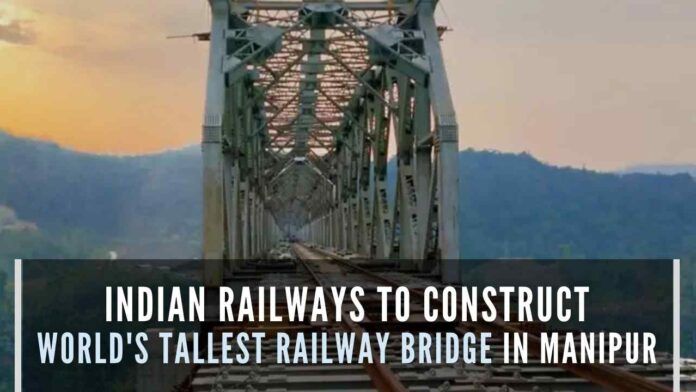
Indian Railways Jiriram-Imphal Line: World’s tallest railway bridge coming up in Manipur
Indian Railways in its effort to provide connectivity to various parts especially in the remote areas is taking multiple steps where transportation is still a major problem for the people living in those areas.
The bridge, which is being built at a pier height of 141 meters, will surpass the existing record of 139 meters of Mala – Rijeka viaduct, Montenegro in Europe
India’s northeast region is the 6th most quake-prone belt in the world, the soil of the young Himalayan region is fragile and due to the heavy monsoon, the working season is very less.
However, despite these challenges the world’s tallest railway bridge is being built in Manipur’s Noney mountainous valley as part of the 111 km-long Jiribam-Imphal new railway line. The 111 km-long Jiribam-Imphal railway line will reduce travel time from the existing 10-12 hours to 2.5 hours.
The bridge is being constructed since 2015, in Tamenglong district in western Manipur at a cost of Rs.374 crore as an essential part of the Rs.14,320 crore broad gauge railway lines that would connect the Manipur capital Imphal by December 2023.
After the completion of the railway line (Jiribam-Imphal) by 2023, Manipur capital Imphal would be the fourth capital city in the mountainous northeastern region to be connected after Assam’s main city of Guwahati (adjoining capital Dispur), Tripura capital Agartala, and Arunachal Pradesh’s Naharlagun (adjacent to capital city Itanagar).
The Manipur railway projects’ Chief Engineer Sandeep Sharma said that the northeast region is the 6th most quake-prone belt in the world, the soil of the young Himalayan region is weak and due to the heavy monsoon for a longer period, the working season is very less in the hilly region.
“Despite numerous odds, challenges, and problems of transportation of the construction material, around 60 percent of work on the oversized bridge has been completed and the entire work would be finished in August next year,” Sharma said.
He said that considering the geographical condition and the quake threat, the structure of the bridge has been designed accordingly and expertise from various international consultants and IITs in India including IIT Kharagpur has been obtained. Various expert committees have also been formed for guidance.
The North-East Frontier Railways (NFR) is laying tracks to connect the capital cities of two more northeastern states — Mizoram and Nagaland.
NFR Chief Public Relations Officer Guneet Kaur said that the NFR will build eight new station buildings, 11 major bridges, 134 minor bridges, four road overbridges, 12 road underbridges, and a record length of over 71,066 meters of tunnelling.
The timely completion of this project is very crucial for further extending rail connectivity to Myanmar in the future, in keeping with the “Act East Policy” of the Indian government, the official said.
A senior engineer of the NFR (construction wing) said that for the first time in India, a safety tunnel for the safe evacuation of people during any emergency at tunnel number 12 has been constructed on the Jiribam-Tupul-Imphal railway line which is significant as the section would have the tallest bridge in the world and the longest railway tunnel in India.
Completion of the project will expose the rich culture of Manipur to the world, he said.
The 11.55 km long tunnel number 12 is the longest railway tunnel in India on the Jiribam-Tupul-Imphal railway line and is longer than the famous Pir Panjal tunnel (8.5 km) on the Banihal-Qazigund line in Jammu and Kashmir.
The approximate cost for the construction of this tunnel, which lies in the two districts of Manipur, Senapati, and Imphal West, and is situated in the western part of the Imphal Valley, would be Rs.930 crore.
“For the safe evacuation of people during any emergency at tunnel number 12, a parallel 9.35 km long safety tunnel has been constructed as per international technical specifications. The main tunnel and parallel safety tunnel will be connected through cross passages at every 500 meters. Rs.368 crores were spent to construct the safety tunnel,” the engineer said.
The NFR, one among the 17 railway zones in India, operates fully and partially in six of the eight northeastern states, excluding Meghalaya and Sikkim, and in seven districts of West Bengal and five districts of north Bihar.
The NFR engineers said the landscape, soil conditions, and other natural challenges have forced the railways to invest more money and to confront diverse challenges in the northeastern region.
“Soil or earth-bearing capacity of the northeastern region is much less compared to other parts of the country. But for the railway engineers, nothing is impossible,” the NFR engineer claimed.
[With Inputs from IANS]
PGurus is now on Telegram. Click here to join our channel and stay updated with all the latest news and views
For all the latest updates, download PGurus App.
- Siddaramaiah govt under NCBC lens after it pushes for Religion-based quota in Karnataka - April 24, 2024
- RBI bans Kotak Mahindra Bank from onboarding new customers via online, mobile banking channels and issuing new credit cards - April 24, 2024
- JP Morgan CEO lauds economic reforms by Modi govt; says PM Modi lifted 400 mn people out of poverty - April 24, 2024










